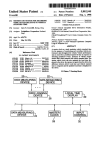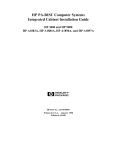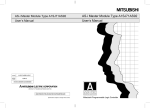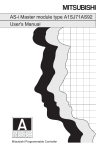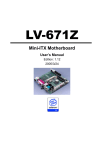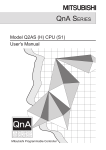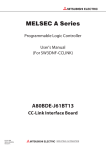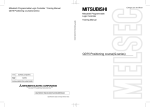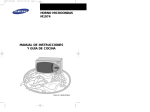Download A1S66ADA,Analog Input/Output Module,User,s Manual
Transcript
Analog Input/Output Module Type A1S66ADA , User s Manual MODEL A1S66ADA-U-E MODEL CODE 13JL41 Analog Input/Output Module Type A1S66ADA , User s Manual IB(NA)-66819-F(0410)MEE HEAD OFFICE : 1-8-12, OFFICE TOWER Z 14F HARUMI CHUO-KU 104-6212,JAPAN NAGOYA WORKS : 1-14 , YADA-MINAMI 5-CHOME , HIGASHI-KU, NAGOYA , JAPAN When exported from Japan, this manual does not require application to the Ministry of Economy, Trade and Industry for service transaction permission. Specifications subject to change without notice. Mitsubishi Programmable Logic Controller • SAFETY PRECAUTIONS • (Always read these instructions before using this equipment.) Before using this product, please read this manual and the relevant manuals introduced in this manual carefully and pay full attention to safety to handle the product correctly. The instructions given in this manual are concerned with this product. For the safety instructions of the programmable controller system, please read the CPU module user's manual. In this manual, the safety instructions are ranked as "DANGER" and "CAUTION". DANGER Indicates that incorrect handling may cause hazardous conditions, resulting in death or severe injury. ! CAUTION Indicates that incorrect handling may cause hazardous conditions, resulting in medium or slight personal injury or physical damage. ! Note that the ! CAUTION level may lead to a serious consequence according to the circumstances. Always follow the instructions of both levels because they are important to personal safety. Please save this manual to make it accessible when required and always forward it to the end user. [DESIGN PRECAUTIONS] ! DANGER • In case of the external power supply failure or the programmable controller ( PLC ) failure, set up a safety circuit outside the PLC so that the entire system can operate safely. The mis-output and malfunction may cause an accident. ! CAUTION • Use the PLC in an environment that meets the general specifications contained in this manual. Using this PLC in an environment outside the range of the general specifications could result in electric shock, fires, malfunctions, and damage to or deterioration of the product. • Do not bunch the control wires with the main circuit or power wires, or install them close to each other. They should be installed 100 mm (3.94 inch) or more from each other. Failure to do so may result in noise that would cause malfunctions. • At power ON/OFF, voltage or current may instantaneously be output from the output terminal of this module. In such case, wait until the analog output becomes stable to start controlling the external device. [INSTALLATION PRECAUTIONS] ! CAUTION • Insert the tabs at the bottom of the module into the mounting holes in the base unit. If the module is not properly installed, it may result in malfunctions, failure, or fallout. • Do not directory touch the module's conductive parts. Doing so could cause malfunctions or failure in the module. A-1 A-1 [WIRING PRECAUTIONS] ! CAUTION • Ground the AG and FG terminals to the protected grounding conductor when there are a lot of noise. Failure to ground these terminals may cause malfunctions. • When wiring PLC, check the rated voltage and terminal layout of the wiring, and make sure the wiring is done correctly. Connecting a power supply that differs from the rated voltage or wiring it incorrectly may cause fires or failure. • Tighten the terminal screws within the range of specified torque. If the terminal screws are loose, it may result in short circuits or malfunctions. Tightening the screws too far may cause damage to the screw, resulting in short circuits, or malfunctions. • Be sure there are no foreign substances such as sawdust or wiring debris inside the module. Such debris could cause fires, failure, malfunctions. [STARTING AND MAINTENANCE PRECAUTIONS] ! CAUTION • Do not touch the connector while the power is on. Doing so could cause malfunctions. • Be sure to shut off all phases of the external power supply used by the system before cleaning or retightening the terminal screws. If you do not switch off the external power supply, it will cause failure or malfunctions of the module. • Do not disassemble or modify the modules. Doing so could cause failure, malfunctions, injury, or fires. • Be sure to shut off all phases of the external power supply used by the system before mounting or dismounting the module. If you do not switch off the external power supply, it will cause failure or malfunctions of the module. • Before handling the module, always touch grounded metal, etc. to discharge static electricity from the human body. Failure to do so can cause the module to fail or malfunction. [OPERATING PRECAUTIONS] ! DANGER • Do not output (turn ON) the "usage disable" signal as an output signal to special modules from the PLC CPU. Outputting the "usage disable" signal may cause PLC system malfunctions. [DISPOSAL PRECAUTIONS] ! CAUTION • When disposing of this product, treat it as industrial waste. A-2 A-2 REVISIONS The manual number is given on the bottom left of the back cover. Print Date Jan., 1998 Feb., 1998 Manual Number IB(NA)-66819-A IB(NA)-66819-B Revision First printing Correction Section 4.4 Apr., 2001 IB(NA)-66819-C Addition WARRANTY Correction SAFETY PRECAUTIONS, Chapter2, Section3.1, 3.2, 3.3.3, 3.4.3, 4.2, 4.5.2, 5.3 Mar., 2003 IB(NA)-66819-D Correction SAFETY PRECAUTIONS, Section3.1, 3.2, 5.3, Appendix1 July, 2003 IB(NA)-66819-E Correction Section5.3 Addition Appendix3 Oct., 2004 IB(NA)-66819-F Correction SAFETY PRECAUTIONS, Section 4.5.2 June, 2005 IB(NA)-66819-G Addition Conformation to the EMC Directive and Low Voltage Instruction Correction SAFETY PRECAUTIONS, Chapter 5 Japanese Manual Version SH-3642-H This manual confers no industrial property rights or any rights of any other kind, nor does it confer any patent licenses. Mitsubishi Electric Corporation cannot be held responsible for any problems involving industrial property rights which may occur as a result of using the contents noted in this manual. © 1998 MITSUBISHI ELECTRIC CORPORATION A-3 A-3 INTRODUCTION Thank you for purchasing the Mitsubishi Graphic Operation Terminal. Before using the equipment, please read this manual carefully to develop full familiarity with the functions and performance of the graphic operation terminal you have purchased, so as to ensure correct use. Please forward a copy of this manual to the end user. CONTENTS 1 OVERVIEW 1 - 1 to 1 - 3 1.1 Features ................................................................................................................................................. 1 - 2 1.2 Comparison with A1S63ADA................................................................................................................. 1 - 3 2 SYSTEM CONFIGURATION 2 - 1 to 2- 2 3 SPECIFICATION 3 - 1 to 3 -13 3.1 General Specification............................................................................................................................. 3 - 1 3.2 Performance Specifications ................................................................................................................... 3 - 2 3.3 D/A Conversion I/O Characteristics....................................................................................................... 3 - 4 3.3.1 Voltage output characteristic........................................................................................................... 3 - 5 3.3.2 Current output characteristic........................................................................................................... 3 - 6 3.3.3 Overall accuracy.............................................................................................................................. 3 - 7 3.4 A/D Conversion I/O Characteristic......................................................................................................... 3 - 8 3.4.1 Voltage input characteristic............................................................................................................. 3 - 9 3.4.2 Current input characteristic ............................................................................................................ 3 - 10 3.4.3 Overall accuracy............................................................................................................................. 3 - 11 3.5 I/O Signals Against the PLC CPU ........................................................................................................ 3 - 12 3.5.1 List of I/O signals ............................................................................................................................ 3 - 12 3.5.2 I/O signal functions......................................................................................................................... 3 - 13 4 PROCEDURES AND SETTINGS BEFORE OPERATION 4 - 1 to 4 -12 4.1 Procedures before Operation ................................................................................................................ 4 - 1 4.2 Handling Precautions............................................................................................................................. 4 - 2 4.3 Installation and Removal of the Shield Cover ....................................................................................... 4 - 3 4.4 Part Identification and Settings .............................................................................................................. 4 - 4 4.5 Wiring...................................................................................................................................................... 4 - 7 4.5.1 Precautions when wiring ................................................................................................................. 4 - 7 4.5.2 Wiring between the A1S66ADA and the external devices ............................................................ 4 - 8 4.6 Fine Adjustment of the Offset /Gain Values......................................................................................... 4 - 10 4.6.1 Fine adjustment methods of the offset/gain values....................................................................... 4 - 10 4.7 Maintenance and Inspection................................................................................................................. 4 - 12 A-4 A-4 5 PROGRAMMING 5 - 1 to 5 - 4 5.1 Program Creation Procedures............................................................................................................... 5 5.1.1 Outputting digital values as voltage/current (D/A conversion)....................................................... 5 5.1.2 Receiving voltage/current as digital values (A/D conversion)........................................................ 5 5.2 Basic Read and Write Programs ........................................................................................................... 5 5.3 Program Example .................................................................................................................................. 5 6 TROUBLESHOOTING APPENDIX 1 1 1 2 3 6 - 1 to 6- 2 App - 1 to App - 5 Appendix 1 Comparison with the Conventional Analog I/O Module (A1S63ADA) ................................App - 1 Appendix 2 External Dimensions.............................................................................................................App - 3 Appendix 3 Precautions For Reading A Digital Output Value (For Hardware Version "C" or Earlier) ...App - 4 A-5 A-5 Conformance to the EMC Directive/Low Voltage Directive When incorporating the Mitsubishi PLC into other machinery or equipment and keeping compliance with the EMC and low voltage directives, refer to Chapter 3, "EMC Directives and Low Voltage Directives" of the User's Manual (Hardware) included with the CPU module or base unit used. The CE logo is printed on the rating plate on the main body of the PLC that conforms to the EMC directive and low voltage instruction. By making this product conform to the EMC directive and low voltage instruction, it is not necessary to make those steps individually. A-6 A-6 1 OVERVIEW MELSEC-A 1 OVERVIEW 1 This user's manual describes the handling, specifications and programing method of the A1S66ADA type Analog I/O Module (hereafter referred to as A1S66ADA), which is utilized in combination with the MELSEC-A series CPU module (hereafter referred to as PLC CPU).The A1S66ADA is a special module with a four-channel analog input and two-channel analog output. (Hereinafter, D/A conversion shall mean digital to analog conversion and A/D conversion shall mean analog to digital conversion.) (1) D/A conversion Digital values are converted to analog values such as voltage and current, and output externally. (V) + 100 300 200 -100 400 -300 500 200 Digital values Analog values t 0 – (2) A/D Conversion Analog values such as voltage and current are converted to digital values so they can be imported into the PLC CPU. (V) + (V) + Analog values 0 – Digital values t 0 t – The voltage, current and digital values that the A1S66ADA may input or output are ranged as follows: Voltage I/O range······0 to 10 V, 1 to 5 V, -10 to 10 V, 0 to 20 mA (switched by range) Current I/O range······0 to 20 mA, 4 to 20 mA (switched by range) Digital output value····0 to 4095 (12 bit binary value) Digital input value······0 to 4000 (12 bit binary value) 1-1 1-1 1 OVERVIEW MELSEC-A 1.1 Features 1 (1) High-speed D/A conversion and A/D conversion are possible. The A1S66ADA can perform conversion at high speeds, as shown below: 240 μs/2 CH or below (for D/A conversion) 400 μs/4 CH or below (for A/D conversion) (2) High-speed sequence scan is possible Because the reading and writing of digital and analog values is performed using I/O signals (X/Y) instead of the buffer memory, which conventionally has been used, the A1S66DA can reduce the sequence scan time. Buffer memory method TO H0 D0 K5 K1 FROM H0 K1 D1 K1 Processing time Item Command The digital value to undergo D/A conversion is written. The digital value that has been undergone A/D conversion is read. A2USHCPU Q2ASHCPU TO 212.1 μs 162.0 μs FROM 183.5 μs 160.0 μs 395.6 μs 322.0 μs Total I/O signal (X/Y) format MOV (D/A conversion) MOV (A/D conversion) Total D0 K3Y0 MOV K3X0 D100 The digital value to undergo D/A conversion is written. The digital value that has been undergone A/D conversion is read. Processing time Item Command MOV A2USHCPU Q2ASHCPU 0.55 μs 0.30 μs 0.55 μs 0.30 μs 1.10 μs 0.60 μs (3) D/A conversion and A/D conversion may be performed with one module. An A1S66ADA module can perform D/A conversion at two channels and A/D conversion at four channels. 1-2 1-2 1 OVERVIEW MELSEC-A 1.2 Comparison with A1S63ADA The following is a comparison with the conventional analog I/O module (A1S63ADA). 1. Number of channels A1S66ADA A1S63ADA Number of Type Output 2 channels 1 channel channels Input 4 channels 2 channels Type A1S66ADA A1S63ADA D/A conversion Conversion speed A/D conversion 240 µs/2 channels or below (Resolution 1/4000) 400 µs/4 channels or below (Resolution 1/4000) 2. Maximum conversion speed 1 µs/CH (Resolution 1/4000) 2 µs/CH (Resolution 1/8000) 3 µs/CH (Resolution 1/12000) 3. D/A conversion Type A1S66ADA Voltage output Current output Digital input 0 to 4000 (12 - bit binary value) Analog output Voltage: -10 to 10 V DC (External load resistance 2 kΩ to 1 MΩ) Current: 0 to 20 mA DC (External load resistance 0 Ω to 600 Ω) A1S63ADA Voltage output Current output 0 to 4000 -4000 to 4000 (Resolution 1/4000) (Resolution 1/4000) 0 to 8000 -8000 to 8000 (Resolution 1/8000) (Resolution 1/8000) 0 to 12000 -12000 to 12000 (Resolution 1/12000) (Resolution 1/12000) Voltage: -10 to 0 to 10 V DC (External load resistance 2 kΩ to 1 MΩ) Current: -20 to 20 mA DC (External load resistance 0 Ω to 600 Ω) 4. A/D conversion Type A1S66ADA A1S63ADA Analog input Voltage: -10 to 0 to 10 V DC (Input resistance 1 MΩ) Current: 0 to 20 mA DC (Input resistance 250 Ω) Voltage: -10 to 0 to 10 V DC (Input resistance 1 MΩ) Current: -20 to 20 mA DC (Input resistance 250 Ω) Digital output 0 to 4095 (12 - bit binary value) -4096 to 4095 (Resolution 1/4000) -8192 to 8191 (Resolution 1/8000) -12288 to 12287 (Resolution 1/12000) 5. Accuracy Type Accuracy 1-3 A1S66ADA A1S63ADA Within ± 1 % 1-3 2 SYSTEM CONFIGURATION MELSEC-A 2 SYSTEM CONFIGURATION (1) Applicable CPU · A1SCPU(S1) · A1SJCPU(S3) · A2ASCPU(S1/S30) · A2SCPU(S1) · A1SJHCPU(S8) · A1SHCPU · A2SHCPU(S1) · A2USHCPU-S1 · Q2ASCPU(S1) · Q2ASHCPU(S1) · A1SCPU24-R2 2 · A52GCPU(T21B) (2) Number of modules loaded As long as the number of I/O points for the applicable CPU is not exceeded, there is no limit in the number of modules used. (3) Slots for loading The module may be loaded into any of the base module slots, expect the following: If the module is loaded in a slot on an extension base module that is not equipped with a power supply module (A1S52B, A1S55B or A1S58B), the power capacity may be insufficient to cover all the modules. When loading to an A1S66ADA extension base module without a power supply module, select a proper power supply module, basic base module, extension base module and extension cable by taking the following points into consideration: 1) Current capacity of the power supply module on the basic base module 2) Voltage drops of the basic base module 3) Voltage drops of the extension base module 4) Voltage drops in the extension cable (4) Data link system In a data link system, the module may be loaded to the master station, local station or remote I/O station. Refer to the MELSECNET or MELSECNET/B Data Link System Reference Manual for program examples for remote I/O stations. Remark Refer to the respective manual listed below for calculation methods for the range of I/O points and voltage drops. This shows the system configuration when using the graphics software to create monitor screens. • A1SJCPU(S3) User's Manual·····························································IB(NA)-66446 • A1S/A1SC24-R2/A2SCPU(S1) User's Manual··································IB(NA)-66320 • A2ASCPU(S1/S30) User's Manual·····················································IB(NA)-66455 • A2USHCPU-S1 User's Manual···························································IB(NA)-66789 • A1SJH(S8)/A1SH/A2SHCPU(S1) User's Manual······························IB(NA)-66779 • Q2AS(H)CPU(S1) User's Manual·······················································SH(NA)-3599 2-1 2-1 2 SYSTEM CONFIGURATION MELSEC-A MEMO 2 2-2 2-2 3 SPECIFICATION MELSEC-A 3 SPECIFICATION This section explains the A1S66ADA the general specifications, performance specifications and I/O signals. 3.1 General Specification This section explains the A1SJ71PB92D general specifications. Table 3.1 General specification 3 Item Specifications Operating ambient 0 to 55 °C temperature Storage ambient -20 to 75 °C temperature Operating ambient 10 to 90 % RH, No condensation humidity Storage ambient 10 to 90 % RH, No condensation humidity Frequency Conforming Vibration to JIS B resistance 3502, IEC 61131-2 When there is intermittent vibration When there is continuous vibration Shock resistance Acceleration 10 to 57 Hz — (0.003 in.) 2 57 to 150 Hz 9.8 m/s 10 to 57 Hz — 57 to 150 Hz Sweep Count — 10 times each in X, Y 0.035 mm and Z axis (0.001 in.) (80 minutes) 2 4.9 m/s — 2 Conforming to JIS B3502, IEC 61131-2 (147 m/s , 3 times each in 3 directions) Operating No corrosive gas present environment Operating height 2000 m(6562 ft) or less Installation area On the control board Over-voltage category 1 Pollution rate Amplitude 0.075 mm II or less 2 2 or less 1: Indicates the distribution area where the device is assumed to be connected, from the public power distribution network to the local machine device. Category II is applied to the devices to which the power is supplied from a fixed equipment. The surge resistance voltage of a rated 300 V device is 2500 V. 2: This is an index which indicates the occurrence rate of the conductive object in the environment where the device is used. Pollution rate II indicates that only non-conductive pollution may occur with a possibility of generating temporary conductivity due to accidental condensation. 3: Do not use or store the PLC under pressure higher than the atmospheric pressure of altitude 0m. Doing so can cause a malfunction. When using the PLC under pressure, please contact your sales representative. 3-1 3-1 3 SPECIFICATION MELSEC-A 3.2 Performance Specifications The Table 3.2 describes the performance specifications of the A1S66ADA. Table 3.2 Performance specification of the A1S66ADA Item Performance specifications — Voltage output Digital input Current output 0 to 4000 (12-bit binary value) -10 to 10 V DC (External load resistance : 2 kΩ to 1 MΩ) Analog output 0 to 20 mA DC (External load resistance : 0 Ω to 600 Ω) Analog output I/O characteristics 1 D/A conversion 0 to 10 V range 0 to 5 V range 1 to 5 V range -10 to 10 V range Digital input 0 to 20 mA range 4 to 20 mA range 0 1000 2000 3000 4000 0V 2.5 V 5V 7.5 V 10 V 0V 1.25 V 2.5 V 3.75 V 5V 1V 2V 3V 4V 5V -10 V -5 V 0V 5V 10 V 0 1000 2000 3000 4000 0 mA 5 mA 10 mA 15 mA 20 mA 4 mA 8 mA 12 mA 16 mA 20 mA 1.25 mV 1.0 mV 5.0 mV 5 μA 4 μA Maximum resolution Conversion speed 2.5 mV 2 240 μs/2 channels or less (Sampling : 80 μs/1 channel) Absolute maximum output Output short protection Voltage : ±12 V 2 channels Adjust the two channels simultaneously with the control knob on the front side of the module. The adjustment should be done on-line. Offset/gain adjustment Voltage : -10 to 0 to 10 V DC (Input resistance: 1 MΩ) Current: 0 to 20 mA DC (Input resistance: 250 Ω) Analog input Digital output Analog input (voltage) 0 to 10 V range 3 D/A conversion Maximum resolution Conversion speed 4 Absolute maximum input Analog input points Offset/gain adjustment 3-2 Current : +28 mA Present Analog output points I/O characteristics Analog output Digital input 0 to 4095 (12-bit binary value) Analog input (current) -10 to10 V range 0 to 20 mA range 4 to 20 mA range Digital output 1V 2V 3V 4V 5V -10 V -5 V 0V 5V 10 V 0 mA 5 mA 10 mA 15 mA 20 mA 4 mA 8 mA 12 mA 16 mA 20 mA 0 1000 2000 3000 4000 1.0 mV 5.0 mV 5 μA 4 μA 0 to 5 V range 1 to 5 V range 0V 2.5 V 5V 7.5 V 10 V 0V 1.25 V 2.5 V 3.75 V 5V 2.5 mV 1.25 mV 400 μs/4 channels or less (Sampling : 80 μs/1 channel) Voltage : ±15 V Current : ±30 mA 4 channels Adjust the four channels simultaneously with the control knob on the front side of the module. Check the digital output value on-line while making the adjustments. 3-2 3 3 SPECIFICATION MELSEC-A Table 3.2 Performance specification of the A1S66ADA (continued) Item Overall accuracy Performance specifications D/A conversion (accuracy against the maximum value) A/D conversion (accuracy against the scale) current output Within ±1% (±100 mV) Within ±1% (±200 µA) Within ±1% (±40) Between I/O terminals and PLC power supply········Photocoupler isolation Between each channel········No isolation Insulation method 64 points (Input 64 points, output 64 points) Number of occupying I/O points Connecting terminal base 20-point terminal base (M3.5 0.75 to 1.25 mm Applicable wire size 5 7 screws) 2 R1.25 - 3 1.25 - YS3 2 - 3.5 2 - YS3A V1.25 - M3 V1.25 -YS3A V2 - S3 V2 - YS3A Applicable solderless terminal 5 V DC internal current consumption External power supply Voltage output Voltage 0.21 A 21.6 to 26.4 V DC Current consumption 0.16 A Weight 0.33 kg 1 The analog output range is set commonly for CH1 to CH2. 2 The conversion speed refers to the speed between the times when a digital value is written to the A1S66ADA and when an analog output which corresponds to the aforementioned value begins to be outputted. 3 The analog input range is set commonly for CH3 to CH6. 4 The conversion speed refers to the speed while a change in an analog input is converted to a digital output. (Excluding the sequence scan) 5 Inputs and outputs are assigned to the same number. Therefore, the I/O occupied points are 64. POINT When utilizing the peripheral device to assign the I/O numbers, set it as a 64-point output module. 3-3 3-3 3 SPECIFICATION MELSEC-A 3.3 D/A Conversion I/O Characteristics The I/O characteristic of D/A conversion will be explained below. (1) I/O conversion characteristic The I/O conversion characteristic refers to the angle produced by a straight line connecting the "offset value" and "gain value" created when the digital values set by the PLC CPU are converted to analog values (voltage or current). (2) Offset value and gain value Offset value and gain value are defined as follows: (a) Offset value···The current value or voltage value that is output from the A1S66ADA when the digital value set by the PLC CPU is "0." (b) Gain value·····The current value or voltage value that is output from the A1S66ADA when the digital value set by the PLC CPU is "4000." (3) I/O conversion characteristic Examples of A1S66ADA's I/O conversion characteristic are shown below. When the offset value is -10V and gain value is 10V (V) Analog output voltage 10 5 Gain value 0 -5 -10 0 2000 4000 Digital input value Offset value Voltage output characteristic When the offset value is 0 mA and gain value is 20 mA (mA) Analog output current 10 5 Gain value 0 -5 -10 0 Offset value 2000 4000 Digital input value Current output characteristic 3-4 3-4 3 SPECIFICATION MELSEC-A 3.3.1 Voltage output characteristic An example of voltage output characteristic graph when the offset and gain settings are changed is shown in Fig. 3.1. (V) Analog output voltage 10 1) 5 3) The I/O conversion characteristic when the off set value and gain value are set, as shown in the table below, is shown in the figure at left. 2) 0 Offset value Gain value 1) 0V 10 V 2) 0V 5V 3) 1V 5V 4) -10 V 10 V 4) -5 -10 2000 Digital input value 0 4000 Fig. 3.1 Voltage output characteristic graph [Example] On the characteristic graphs 1) to 4), the analog output voltage will be as follows when the digital input value is set to 500 and 2000: No. 1) 2) 3) 4) 3-5 Digital input value Analog output value 500 1.25 V 2000 5V 500 0.625 V 2000 2.5 V 500 1.5 V 2000 3V 500 -7.5 V 2000 0V 3-5 3 SPECIFICATION MELSEC-A 3.3.2 Current output characteristic An example of current output characteristic graph when the offset and gain settings are changed is shown in Fig. 3.2. (m A) Analog output current 20 15 2) 10 The I/O conversion characteristic when the off set value and gain value are set, as shown in the table below, is shown in the figure at left. 1) 5 Offset value Gain value 1) 0 mA 20 mA 2) 4 mA 20 mA 0 4000 2000 0 Digital input value Fig. 3.2 Current output characteristic graph [Example] On the characteristic graphs 1) to 2), the analog output voltage will be as follows when the digital input value is set to 1000 and 2000: No. 1) 2) 3-6 Digital input value Analog output value 1000 5 mA 2000 10 mA 1000 8 mA 2000 12 mA 3-6 3 SPECIFICATION MELSEC-A 3.3.3 Overall accuracy Overall accuracy refers to the accuracy relative to the maximum analog output value. Even if the output characteristic is altered by changing the offset/gain settings, the overall accuracy does not change but is maintained within the performance range as outlined in the specifications. The overall accuracy of voltage and current output characteristics are shown in Fig. 3.3 and 3.4. The overall accuracy of the voltage output is the accuracy against 10V. Analog output value +10V Fluctuation will be within 10 V ±1% (100 mV) width due to the operating environment (ambient temperature, noise). 0V -10V 0 2000 Digital input value 4000 Fig. 3.3 Overall accuracy of voltage output characteristics The overall accuracy of the current output is the accuracy against 20 mA. 20mA Analog output value Fluctuation will be within 20 mA ±1% (200 µA) width due to the operating environment (ambient temperature, noise). 0mA 0 Digital input value 4000 Fig. 3.4 Overall accuracy of current output characteristic 3-7 3-7 3 SPECIFICATION MELSEC-A 3.4 A/D Conversion I/O Characteristic The I/O characteristic of A/D conversion will be explained below. (1) I/O conversion characteristic The I/O conversion characteristic refers to the angle produced when the "offset value" and "gain value" created when the analog values (voltage or current) from outside the PLC are converted to digital values are connected with a straight line. The I/O conversion characteristic refers to the angle produced by a straight line that connects the "offset value" and "gain value" created when the digital values set by the PLC CPU are converted to analog values (voltage or current). (2) Offset value and gain value Offset value and gain value are defined as follows: (a) Offset value····The analog value (voltage or current) that makes the digital output value "0." (b) Gain value······The analog value (voltage or current) that makes the digital output value "4000." (3) I/O conversion characteristic Examples of A1S66ADA's I/O conversion characteristic are shown below. When the offset value is -10 V and gain value is 10 V Digital output value 4000 3000 Gain value 2000 1000 0 -10 Offset value 0 Analog input voltage (V) 10 Voltage input characteristic When the offset value is 0 mA and gain value is 20 mA Digital output value 4000 3000 Gain value 2000 1000 0 0 10 Analog input current (mA) 20 Offset value Current input characteristic 3-8 3-8 3 SPECIFICATION MELSEC-A 3.4.1 Voltage input characteristic An example of voltage input characteristic graph when the offset/gain settings are changed is shown in Fig. 3.5. Digital output vallue 4000 3000 The voltage input characteristic when the offset value and gain value are set as shown in the table below, is shown in the figure. 3) 2000 2) 1) Offset value Gain value 1) 0V 10 V 2) 0V 5V 3) 1V 5V 4) -10 V 10 V 4) 1000 0 10 0 -10 Analog input voltage (V) Fig. 3.5 Voltage input characteristic graph [Example] On the characteristic graphs 1) to 4), the digital output voltage will be as follows when the analog input value is set to 1 V and 3 V: No. Analog input value Digital output value 1V 400 3V 1200 1V 800 3V 2400 1) 2) 3) 4) 1V 0 3V 2000 1V 2200 3V 2600 POINT • When a voltage that exceeds the range of -15 V to 15 V is input, the elements may be damaged. • The overall accuracy is the accuracy outlined in the performance specifications when the input voltage is in the range of -10 to 10 V. If the input voltage is outside the range of -10 to 10 V, the accuracy may not be as indicated in the performance specifications. • When a value which causes the digital output value to exceed the maximum (4095) or minimum (0) digital value is input, the digital output value will be fixed at the maximum (4095) or minimum (0) digital value. 3-9 3-9 3 SPECIFICATION MELSEC-A 3.4.2 Current input characteristic An example of current input characteristic graph when the offset/gain settings are changed is shown in Fig. 3.6. (V) Digital output vallue 4000 3000 The current input characteristic when the offset value and gain value are set as shown in the table below is shown in the figure at left. 2000 1) 1000 2) 0 10 Analog input current (m A) 0 20 Offset value Gain value 1) 0 mA 20 mA 2) 4 mA 20 mA Fig. 3.6 Current input characteristic graph [Example] On the characteristic graphs 1) to 2), the digital output current will be as follows when the analog input value is set to 5 mA and 12 mA: No. Analog input value Digital output value 1) 2) 5 mA 1000 12 mA 2400 8 mA 250 12 mA 2000 POINT • When a current exceeding the range of -30mA to 30mA is input, the elements may be damaged due to heating. • The overall accuracy is the accuracy outlined in the performance specifications when the input current is in the range of 0 to 20mA. If the input current is outside the range of 0 to 20mA, the accuracy may not be as indicated in the performance specifications. • When a value which causes the digital output value to exceed the maximum (4000) or minimum (0) digital value is input, the digital output value will be fixed at the maximum (4000) or minimum (0) digital value. 3 - 10 3 - 10 3 SPECIFICATION MELSEC-A 3.4.3 Overall accuracy The overall accuracy refers to the accuracy relative to the maximum digital output value. Even if the I/O characteristic is altered by changing the offset/gain settings, the overall accuracy does not change but is maintained within the performance range as outlined in the specification. The overall accuracy of voltage and current input characteristics are shown in Fig. 3.7 and 3.8. Offset value -- 0 V, gain value -- 10 V, resolution -- 1/4000 4000 Digital output value 3000 ±1 % (±40) 2000 -5 5 1000 0-15 -10 0 Analog input voltage (V) 15 10 Fig. 3.7 Overall accuracy of voltage input characteristic 4095 Offset value -- 0 mA, gain value -- 20 mA, resolution -- 1/4000 4000 Digital output value ±1 % (±40) 2000 0 0 10 Analog input current (mA) 20 Fig. 3.8 Overall accuracy of current input characteristic 3 - 11 3 - 11 3 SPECIFICATION MELSEC-A 3.5 I/O Signals Against the PLC CPU 3.5.1 List of I/O signals The A1S66ADA utilizes 64 input points and 64 output points for the communication with the PLC CPU. The device numbers of the I/O signals and signal names are shown in Table 3.3. The device X indicates the input signal from the A1S66ADA to the PLC CPU, and the device Y the output signal from the PLC CPU to the A1S66ADA. The I/O numbers indicated the occasion when the A1S66ADA is installed in the "slot 0" of the basic base. Table 3.3 List of the A1S66ADA I/O signals Signal Direction A1S66ADA PLC CPU Signal Direction PLC CPU A1S66ADA Device No. Signal Name Device No. Signal Name X00 to X0B CH3 digital output value Y00 to Y0B CH1 digital value setting X0C to X0F Usage disable Y0C to Y0E X10 to X1B CH4 digital output value X1C to X1F Usage disable X20 to X2B CH5 digital output value X2C to X2F Usage disable X30 to X3B CH6 digital output value X3C to X3F Usage disable Y0F Usage disable CH1 D/A conversion value output enable flag Y10 to Y1B CH2 digital value setting Y1C to Y1E Usage disable Y1F Y20 to Y3F CH2 D/A conversion value output enable flag Usage disable POINT • Do not output (turn ON) the "usage disable" signal as an output signal to special modules from the PLC CPU. Outputting the "usage disable" signal may cause PLC system malfunctions. 3 - 12 3 - 12 3 SPECIFICATION MELSEC-A 3.5.2 I/O signal functions I/O signal functions of the A1S66ADA are explained below. (1) X00 to X0B, X10 to X1B, X20 to X2B, X30 to X3B: Digital output value The A/D converted digital values in CH3 to CH6 are stored in Xn0 to XnB as binary data, as shown below: XnB XnA Xn9 Xn8 Xn7 Xn6 Xn5 Xn4 Xn3 Xn2 Xn1 Xn0 b11 b10 b9 b8 b7 b6 b5 b4 b3 b2 b1 b0 Xn0 Digital output value (0 to 4095) (Example) When the digital output value in CH3 is 2000 (H07D0) XnB 0 XnA Xn9 1 1 Xn8 Xn7 Xn6 Xn5 Xn4 Xn3 Xn2 Xn1 1 1 1 0 1 0 0 0 7 D 0 0 (2) Y00 to Y0B, Y10 Y1B: Digital value setting The digital values to be D/A converted in CH1 and CH2 are set in Yn0 to YnB as binary data, as shown below: YnB YnA Yn9 Yn8 Yn7 Yn6 Yn5 Yn4 Yn3 Yn2 Yn1 Yn0 b11 b10 b9 b8 b7 b6 b5 b4 b3 b2 b1 b0 Digital value setting (0 to 4000) (Example) When the digital value in CH2 is set to 2500 (H09C4) YnB YnA Yn9 Yn8 Yn7 1 0 0 1 1 9 Yn6 Yn5 Yn4 Yn3 Yn2 Yn1 Yn0 1 0 0 0 1 0 0 C 4 (3) Y0F, Y1F: CH1, CH2 D/A conversion value output enable flag Outputting the D/A converted analog value to outside the module may be enabled or disabled. ON·······Output enabled The D/A converted analog value is output externally. OFF·····Output disabled The analog value 0 V/0 mA is output. 3 - 13 3 - 13 4 PROCEDURES AND SETTINGS BEFORE OPERATION MELSEC-A 4 PROCEDURES AND SETTINGS BEFORE OPERATION The procedures before operation, handling precautions, name and setting for each area, wiring, etc. will be explained below. 4.1 Procedures before Operation The procedures before the operation of the module are shown in Fig. 4.1 below. Start Module installation • Install the A1S66ADA in the appropriate slot. Wiring 4 Refer to Section 4.5 • Perform wiring for A1S66ADA and external devices. Offset/Gain Settings • Set the offset values and gain values for the channels to be used. Programming, Debugging Refer to Section 4.6 Refer to Chapter 5 • Create and check programs for reading and writing to the A1SA66ADA from the PC CPU. End Fig. 4.1 Procedures before operation 4-1 4-1 4 PROCEDURES AND SETTINGS BEFORE OPERATION MELSEC-A 4.2 Handling Precautions (1) Do not drop or put a great impact on the module case and the terminal block because they are made of resin. (2) Do not take the printed circuit board of the module out of the case. It may result in a failure. (3) Be careful not to let foreign matter such as filings or wire chips get inside the module while wiring. Remove all foreign matters if any get inside. (4) Tighten the module installation screws and terminal screws within the range as follows : 4 Screw Area Tightening Torque Range Module fixing screws (M4 screw) 78 to 118 N·cm Terminal block terminal screws (M3.5 screw) 59 to 88 N·cm Terminal block installation screws (M4 screw) 78 to 118 N·cm (5) When loading the module to the base unit, be sure to insert the module latch to the fixing hole, and secure the module using module mounting screw. When removing the module, be sure to remove the module mounting screw first, then remove the module latch from the fixing hole. Module mounting screw Base unit Module connector Module fixing hole 4-2 Module Module latch 4-2 4 PROCEDURES AND SETTINGS BEFORE OPERATION MELSEC-A 4.3 Installation and Removal of the Shield Cover It is necessary to install the shield cover when using. Procedures for installing and removing the shield cover are described below. (1) Installation Module Shield fixing screw Shield cover To install the shield cover to the module, install the cover to the terminal side first as shown in the figure, then it will be completed by pushing the cover to the module and tightening the shield fixing screw. (2) Removal Module Hole for removal Shield fixing screw Shield cover To remove the shield cover from the module, remove the shield fixing screw first and install the tip of a flat-tip screwdriver into the removal hole as shown in the figure, then move the screwdriver towards the rear of the module to separate the clip from the removal hole and remove the cover. 4-3 4-3 4 PROCEDURES AND SETTINGS BEFORE OPERATION MELSEC-A 4.4 Part Identification and Settings The following describes the part names and settings of the A1S66ADA : 11) 1) A1S66ADA D/A A/D 2) RUN D/A OFFSET 4) 3) 13) A/D GAIN 6) V+ COM C H 1 I+ O U T C H 2 7) 8) 9) 10) C H 3 I N C H 4 C H 5 I N C H 6 1 2 4 I+ V+ I+ 6 V– I– SLD V+ I+ V– I– V+ I+ V– I– SLD V+ I+ V– I– AG (FG) INPUT 24VDC 12) CH3 CH4 CH5 CH6 V I 3 V+ COM D/A A/D 0~±10 V 0~20 mA A1S66ADA 4-4 5) 0-10V 0-5V 1-5V 10-10V 5 7 8 9 14) 10 11 12 13 14 15 16 17 18 19 20 4-4 4 PROCEDURES AND SETTINGS BEFORE OPERATION No. 1) Name RUN LED RUN 2) D/A conversion offset control knob D/A OFFSET 3) D/A conversion gain control knob D/A GAIN 4) A/D conversion offset control knob A/D OFFSET 5) A/D conversion gain control knob A/D GAIN 6) O U T C H 2 Indicates the operating conditions of the A1S66ADA On : Power is ON Off : Power is OFF Used when making a fine adjustment of the D/A conversion offset. The offset value is increased by turning the control knob to the right. The offset value is decreased by turning the control knob to the left. Used when making a fine adjustment of the D/A conversion gain. The gain value is increased by turning the control knob to the right. The gain value is decreased by turning the control knob to the left. Used when making a fine adjustment of the A/D conversion offset. The offset value is increased by turning the control knob to the right. The offset value is decreased by turning the control knob to the left. Used when making a fine adjustment of the A/D conversion gain. The gain value is increased by turning the control knob to the right. The gain value is decreased by turning the control knob to the left. V+ COM I+ V+ COM I+ Analog input terminal (CH3 to CH6) C H 3 I N C H 4 C H 5 I N C H 6 4-5 Description Analog output terminal (CH1, CH2) Outputs the analog values (voltage/current) of CH1 to CH2. Refer to Section 4.5.2 on the wiring method. C H 1 7) MELSEC-A Inputs the analog values (voltage/current) of CH3 to CH6. Refer to Section 4.5.2 on the wiring method. V+ I+ V– I– SLD V+ I+ V– I– V+ I+ V– I– SLD V+ I+ V– I– 4-5 4 PROCEDURES AND SETTINGS BEFORE OPERATION No. Name MELSEC-A Description 8) Analog ground terminal The ground terminal of the analog signal (Refer to Section 4.4 on the wiring method.) 9) Frame ground terminal The ground terminal of the shielded cable (Refer to Section 4.4 on the wiring method.) 10) Power supply input terminal Connect 24 V DC at the input terminal of the power supply. INPUT 24 V DC D/A A/D 0 to ±10 V 0 to 20 mA 11) Analog-output range switching setting pin D/A 0 ~ 10 V 0~5V 1~5V -10 ~ 10 V Set the analog output range. CH1, CH2 common. When setting the current output range, set as follows: When switching to 0 to 20 mA Set a jumper at a position between 0 V and 5 V. When switching to 4 to 20 mA Set a jumper at a position between 1 V and 5 V. Set the jumper as it always makes a line. (Set it with the jumper) (Setting at shipment : 0 to 10 V range ) (Example) When the analog output range is set to 0 to 10 V or 0 to 20 mA, the jumper should be set as follows. D/A D/A Jumper 0 ~ 10 V 0~5V 1~5V -10 ~ 10 V 0 ~ 10 V 0~5V 1~5V -10 ~ 10 V When setting to 0 to 10 V 12) Analog-input voltage/current switching setting pin CH3 CH4 CH5 CH6 Jumper When setting to 0 to 20 mA Set the analog input (voltage input or current input ) for each channel (CH3 to CH6). (Set it with the jumper) (Setting at shipment : V) For voltage input setting : V For current input setting : I V I 13) Analog-input range switching setting pin A/D 0 ~ 10 V 0~5V 1~5V -10 ~ 10 V Set the analog input range. CH3 to CH6 common. When setting the current input range, set as follows: When switching to 0 to 20 mA Set a jumper at a position between 0 V and 5 V. When switching to 4 to 20 mA Set a jumper at a position between 1 V and 5 V. (Setting at shipment : 0 to 10 V range ) (Set it with the jumper) (Example) When the analog input range is set to -10 to 10 V or 4 to 20 mA, the jumper should be set as follows. 0 ~ 10V 0 ~ 5V 1 ~ 5V -10 ~ 10V A/D Jumper A/D 0 ~ 10V 0 ~ 5V 1 ~ 5V -10 ~ 10V When setting to 4 to 20 mA Jumper When setting to -10 to 10 V 14) Terminal block Numbers in a diagram indicates terminal numbers. IMPORTANT When inputting or outputting current, do not set a jumper at a position between 0 V and 10V or between -10 V and 10 V of the analog-input and output range switching setting pin. This may cause a module breakdown or malfunction. 4-6 4-6 4 PROCEDURES AND SETTINGS BEFORE OPERATION MELSEC-A 4.5 Wiring The following describes the precautionary items on wiring as well as wiring to the external devices. 4.5.1 Precautions when wiring To obtain the maximum performance from the functions of A1S66ADA and improve the system reliability, a wiring with the high durability against the noise is required. The external wiring precautions described below make more improvement in the wiring not to be affected by the noise. (1) Use separate cables for the AC and the analog input to the A1S66ADA, in order not to be affected by the AC side surge or conductivity. (2) Do not bundle or place the cable close to the main circuit line, high voltage line or load carrying wires from other than the PLC. It is influenced more easily by the noise, surge, or conductivity. (3) Place a one-point grounding on the PLC side for the shield line or shield cable. However, depending on the external noise conditions, it may be better to have a grounding externally. 4-7 4-7 4 PROCEDURES AND SETTINGS BEFORE OPERATION MELSEC-A 4.5.2 Wiring between the A1S66ADA and the external devices The following shows the wiring method for the A1S66ADA. (1) CH1 and CH2 (a) For voltage output 1 2 CH1 or CH2 D/A conversion circuit Motor drive module, etc. 2k V+ COM to 1M GND (b) For current output 1 2 Motor drive module, etc. CH1 or CH2 D/A conversion circuit I+ COM 0 to 600 GND 1 Use a two-core twisted shield line for the power cable. 2 When noise or ripple occurs with the external cable, connect a condenser with 0.1 to 0.47 µ FWV to the input terminal of the external device. IMPORTANT The voltage and current output can not be used simultaneously on the same channel. In the event it is used, the internal elements are destroyed; therefore always open unused terminals. 4-8 4-8 4 PROCEDURES AND SETTINGS BEFORE OPERATION MELSEC-A (2) CH3 to CH6 (a) For voltage input *3 +15V Signal source 0 to CH3 10 500k V+I+ V-ISLD 500k *1 Shield -15V *2 (b) For current input Signal source 0 to CH6 10 V+I+ V-ISLD FG 500k 250k 500k FG *5 *6 Power supply module GND AG *4 1 Use a two-core twisted shield line for the power cable. 2 Indicates the A1S66ADA input resistance. 3 When noise or ripple occurs with the external cable, connect a condenser with about 0.1 to 0.47 µ F(Part with voltage resistance of 25V or more) between the terminal V+I+ and V-I-. 4 The FG terminal of the power supply module should always be grounded. 5 Make sure to connect between the FG of the power supply module and the FG of A1S66ADA. 6 Due to noise in the environment, AG terminal may attain better accuracy when grounded. POINT The FG terminal of A1S66ADA and the FG terminal of the power supply module are not connected. 4-9 4-9 4 PROCEDURES AND SETTINGS BEFORE OPERATION MELSEC-A 4.6 Fine Adjustment of the Offset /Gain Values Offset/gain values are set by selecting an I/O characteristic, which is preset using the analog input/output range switch setting pins. Each module will have slight characteristic differences from the I/O characteristic selected by the analog input/output range switch setting pins due to the ambient temperature, characteristic variances of the A/D conversion module, and so on. Offset/gain fine adjustment is performed to correct such slight differences in characteristics. 4.6.1 Fine adjustment methods of the offset/gain values The following flow chart describes the fine adjustment procedure of the offset/gain value of A1s66ADA. This setting is for when the module is installed in the slot No. 0, the D/A conversion to CH1 and A/D conversion to CH3. (1) Fine adjustment procedures for the D/A conversion offset/gain values Start Set the analog output range by using the analog-output range switching setting pin. Input the offset value to the output signals Y00 to Y0B. Fine adjustment of the offset value. Turn on the CH1 D/A conversion value output enable flag (Y0F). Adjust the analog output of the CH1 that corresponds to the offset value using "D/A conversion offset control knob". Input the gain value to the output signals Y00 to Y0B. Fine adjustment of the gain value. Adjust the analog output of the CH1 that corresponds to the gain value using "D/A conversion gain control knob". End POINT If the analog output range is set to -10 V to 10 V, and if a fine adjustment of the offset value is performed by setting the offset value to 0 and the analog output to 10 V, the analog output may shift slightly. In such cases, the offset value can be set correctly in one attempt if fine adjustment of the offset value is performed by setting the offset value to 2000 and the analog output to 0 V. 4 - 10 4 - 10 4 PROCEDURES AND SETTINGS BEFORE OPERATION MELSEC-A (2) Fine adjustment procedure for the A/D conversion offset/gain values Start Select the analog input (voltage/current input ) with the analog-input voltage/current switching setting pin. Set the input range by using the analoginput range switching setting pin. Monitor the binary value by the input signals X00 to X0B as 1 word data. Fine adjustment of the offset value. Input to CH3 the voltage/current that corresponds to the offset value. Adjust the CH3 digital output value (X00 to X0B) using "A/D conversion offset control knob" so that the value is the same as the offset value. Input the voltage/current that corresponds to the gain to CH3. Fine adjustment of the gain value. Adjust the CH3 digital output value (X00 to X0B) using "A/D conversion gain control knob" so that the value is the same as the gain value. End POINT Disconnect the power supply for the PLC CPU or the external power supply for A1S66ADA at all phases when setting the output range and making voltage/current selection. 4 - 11 4 - 11 4 PROCEDURES AND SETTINGS BEFORE OPERATION MELSEC-A 4.7 Maintenance and Inspection The A1S66ADA has no particular inspection items, but in order to maintain the system in the best condition, perform inspection according to the categories listed in the PLC CPU Users' Manual. 4 - 12 4 - 12 5 PROGRAMMING MELSEC-A 5 PROGRAMMING The program creation procedures, basic read and write programs, and program examples for A1S66ADA are explained. When utilizing the program example introduced in this chapter for an actual system, fully verify that there are no problems in controllability in the target system. For details of instructions, refer to the ACPU Programming Manual. 5.1 Program Creation Procedures The procedures to create programs are described using flowcharts. 5.1.1 Outputting digital values as voltage/current (D/A conversion) The following flow shows the procedure to create a program that converts the digital value input to CH1 and CH2 into analog values (voltage/current). Start 5 Offset/gain value setting ···················· Initial setting Digital value setting (Y00 to Y0B, Y10 to Y1B) D/A conversion value output enable/disable setting (Y0F, Y1F) End 5.1.2 Receiving voltage/current as digital values (A/D conversion) The following flow shows the procedure to create a program that converts the analog values (voltage/current) input to CH3 to CH6 into digital values. Start Digital output value read (X00 to X0B, X10 to X1B, X20 to X2B, X30 to X3B) End 5-1 5-1 5 PROGRAMMING MELSEC-A 5.2 Basic Read and Write Programs (1) Write to A1S66ADA····················MOV, MOVP instruction Form MOV(P) instruction execution condition MOV (P) Symbol S D S D Description Usable device Number of the head device T, C, D, W, R containing write data, or a constant Head number of the I/O signals X, Y where data is to be stored Example When assigning the A1S66ADA to I/O X40 to X7F and Y40 to Y7F, then writing the binary data stored in D10 to I/O signals Y40 to Y4B 5 MOV instruction execution condition MOV D10 K3Y40 (2) Read from A1S66ADA·····················MOV, MOVP instruction Form MOV(P) instruction execution condition MOV (P) Symbol S D S D Description Usable device Head number of the I/O signals X, Y where data is stored Head number of the device where the data read is to be stored T, C, D, W, R Example When assigning the A1S66ADA to I/O X20 to X5F and Y20 to Y5F, then reading the CH 3 digital output value, which is stored in I/O signals X20 to X2B as binary data, to D20 MOV instruction execution condition MOV 5-2 K3X20 D20 5-2 5 PROGRAMMING MELSEC-A 5.3 Program Example This program example converts the value set by the BCD digital switch into an analog value (voltage/current) and reads the digital values that have undergone A/D conversion at channels 3 through 6. When applying any of the program examples introduced in this chapter to the actual system, verify the applicability and confirm that no problems will occur in the system control. Conditions of program example Power supply module (1) System configuration A 1 S C P U A 1 S 6 6 A D A X/Y00 to X/Y3F A 1 S Y 4 1 A 1 S X 4 1 32 32 points points X40 to X5F Y60 to Y7F I/O number (2) Initial setting description 1) D/A conversion value output enable channel···············1 channel (3) Device to be used by user 1) 2) 3) 4) 5) 6) 7) 8) 9) 5-3 Offset value setting command signal····························X40 Gain value setting command signal······························X41 Digital setting value input command signal···················X42 Digital output value read command signal····················X43 Digital value setting (BCD 4 digits) ·······························X50 to X5F D/A conversion offset value storage data register········D0 D/A conversion gain value storage data register··········D1 Digital output value read detection data register···········D10 to D13 Digital setting value storage data register·····················D20 5-3 5 PROGRAMMING MELSEC-A Offset/gain setting X0040 MOV Offset setting command MOV P K 0 D0 D/A conversion offset setting P K3 D0 Y0000 D/A CH. 1 conversion digital offset value setting setting SET X0041 MOV Gain setting command MOV Y000F CH. 1 D/A output enable D/A conversion offset value 0 is input to Y00 to Y0B. CH. 1 D/A conversion output enable flag is turned ON. P K 4000 D1 D/A conversion gain setting P K3 D1 Y0000 D/A CH. 1 conversion digital gain value setting setting D/A conversion gain value 4000 is input to Y00 to Y0B. Digital value setting/read X0042 BIN Digital setting command MOV X0043 MOV Digital read command MOV MOV MOV K4 X0050 Digital value setting D20 Digital setting storage P K3 X0000 CH. 3 digital output P K3 X0010 CH. 4 digital output P K3 X0020 CH. 5 digital output P K3 X0030 CH. 6 digital output D20 Digital setting storage K3 Y0000 CH. 1 digital value setting Input (X50 to X5F) from BCD digital switch is converted to bynary and then stored in D0. D0 value is input to Y00 to Y0B. D10 CH. 3 analog input value CH. 3 digital output value is read to D10. D11 CH. 4 analog input value CH. 4 digital output value is read to D11. D12 CH. 5 analog input value CH. 5 digital output value is read to D12. D13 CH. 6 analog input value CH. 6 digital output value is read to D13. POINT For modules of hardware version "C" or earlier, excessively large (or small) data may be temporarily read out when a module reads a digital output value from the PLC CPU. To prevent this, refer to Appendix 3 and incorporate a sequence program for ignoring illegal data into the original program. For modules of hardware version "D" or later, such excessively large (or small) data may not be read out. 5-4 5-4 6 TROUBLESHOOTING MELSEC-A 6 TROUBLESHOOTING The following describes the possible causes and the corrective actions for troubles occurred when using the A1S66ADA. (1) When it does not read digital output values Check Item Corrective Action Is the voltage and current supplied properly? Measure using a tester to see whether they are being supplied. Is the conditions for executing the MOV instruction turned on? Check for the ON/OFF status by monitoring from the peripheral device. Are the I/O signals correctly specified in the MOV instruction? Check the sequence program. Is the PLC CPU in the "RUN" state? Position the RUN key switch of the PLC CPU at "RUN". Is the RUN LED of the PLC CPU flashing or turned off? Check the contents by referring to the User's Manual of the PLC CPU. Is there any faulty connections of the analog input signal wires, such as loose wires or wire breakage? Check for the faulty areas of the signal wires by visual inspection and continuity checking. Measure the digital output value by disconnecting the cable for the analog input of the A1S66ADA then applying the test voltage (stabilized power supply or batteries) to the terminal of the main module. Check the grounding method and wiring, as it may be influenced by the noise from the external wiring, if the digital output values are normal at the individual A1S66ADA station. Is the 24VDC power supply turned on? Check the power supply (external power supply). (2) When it does not output analog values Check Item 6-1 Corrective Action Are the D/A conversion value output enable flags (YnF, Y(n+1)F) for CH1 and CH2 turned "ON"? Monitor from the peripheral device to see whether all the conditions to be ON are satisfied. Are the I/O signals correctly specified in the MOV instruction? Check the sequence program. Is the PLC CPU in the "RUN" state? Position the RUN key switch of the PLC CPU at "RUN". Is the RUN LED of the PLC CPU flashing or turned off? Check the contents by referring to the User's Manual of the PLC CPU. Is there any loose wires or wire breakage? Eliminate the faulty area by visual inspection and continuity checking. Is the 24VDC power supply turned on? Check the power supply (external power supply). 6-1 6 6 TROUBLESHOOTING MELSEC-A MEMO 6 6-2 6-2 APPENDIX MELSEC-A APPENDIX Appendix1 Comparison with the Conventional Analog I/O Module (A1S63ADA) Comparison of specifications for A1S66ADA with those for the conventional analog I/O module, A1S63ADA, is shown below. Specification Item A1S66ADA Digital input I/O characteristics D/A conversion A1S63ADA Analog output Digital input 0 to 10 V -4000 to 4000 0 to 5 V -8000 to 8000 1 to 5 V -12000 to12000 0 to 4000 (12-bit binary) -10 to 10V 0 to 4000 0 to 20 mA 0 to 8000 4 to 20 mA 0 to 12000 Analog output -10 to 10 V 4 to 20 mA Voltage 0.83 mV (when resolution is set to 1/12000) Current 1.7 μA (when resolution is set to 1/12000) Maximum resolution Voltage 1.0 mV (when analog output range is set to 1 V to 5 V) Current 4 μA (when analog output range is set to 4 mA to 20 mA) Resolution range switching 2 CH in batch ⎯ Conversion speed 240 μs or below/2 CH 1 ms/1 CH (when resolution is set to 1/4000) 2 ms/1 CH (when resolution is set to 1/8000) 3 ms/1 CH (when resolution is set to 1/12000) Offset/gain adjustment Adjust using the front knob Perform on-line adjustment for the 2 CH in batch Set using the front switch No. of channels 2 channels Analog input 1 channel Digital output Analog input Digital output 0 to 10 V -4000 to 4000 -10 to 10 V 0 to 5 V I/O characteristics 1 to 5 V -8000 to 8000 -12000 to 12000 0 to 4000 (12-bit binary) -10 to 10 V 0 to 20 mA -2000 to 2000 -20 mA to 20 mA 4 to 20 mA A/D conversion App - 1 -4000 to 4000 -6000 to 6000 Voltage 0.83 mV (when resolution is set to 1/12000) Current 3.33 μA (when resolution is set to 1/6000) Maximum resolution Voltage 1.0 mV (when analog input range is set to 1 to 5 V) Current 4 μA (when analog input range is set to 4 to 20 mA) Resolution range switching 4 CH in batch 3 CH in batch (resolution) Individual channels (current/voltage) Conversion speed 400 μs or below/4 CH 1 ms/1 CH (when resolution is set to 1/4000) 2 ms/1 CH (when resolution is set to 1/8000) 3 ms/1 CH (when resolution is set to 1/12000) Offset/gain adjustment Adjust using the front knob of the module Perform on-line adjustment for the 4 CH in batch Set each channel individually using the module front switch No. of channels 4 channels 2 channels App - 1 App. APPENDIX MELSEC-A Specification Item A1S66ADA A1S63ADA Simple loop control Not available Available Analog value read/write method I/O signal method Buffer memory method Overall accuracy Insulation method Number of I/O occupied points Within ±1 % (accuracy relative to the maximum value) Between I/O terminal and PLC power supply··········Photocoupler insulation Between channels····················································No insulation 64 points 32 points Connected terminal base 20 points terminal block (M3.5 × 7 screw) Applicable wire size 0.75 to 1.25 mm2 Applicable solderless terminal R1.25-3 1.25-YS3 2-3.5 2-YS3A V1.25-M3 V1.25-YS3A V2-S3 V2-YS3A 1.25-3.5 1.25-YS3A 2-3.5 2-YS3A V1.25-M3 V1.25-YS3A V2-S3 V2-YS3A 5 V DC internal current consumption 0.21 A 0.8 A Voltage 21.6 to 26.4 V DC ⎯ Current consumption 0.16 A ⎯ 0.33 kg 0.30 kg External power supply Weight App. App - 2 App - 2 APPENDIX MELSEC-A Appendix 2 External Dimensions A1S66ADA D/A A/D RUN OFFSET GAIN V+ COM C H 1 I+ O U T V+ COM C H 2 130 (5.12) I+ V+ I+ C H 3 I N C H 4 C H 5 I N C H 6 V– I– SLD V+ I+ V– I– V+ I+ V– I– SLD V+ I+ V– I– AG (FG) INPUT 24VDC D/A A/D 0~±10 V 0~20 mA A1S66ADA 34.5 (1.36) 93.6 (3.69) Unit: mm (in.) App - 3 App - 3 APPENDIX MELSEC-A Appendix 3 Precautions For Reading A Digital Output Value (For Hardware Version "C" or Earlier) If a digital output value is read from the PLC CPU during A/D conversion processing of the A1S66ADA (For Hardware Version "C" or Earlier), data may be read to the lower order byte (Xn0 to Xn7) and higher order byte (Xn8 to XnB) at different timings. In this case, old A/D conversion data are stored into the lower order byte, and new A/D conversion data into the higher order byte as the read data from the PLC CPU, resulting in data mismatch. (When a carry or borrow occurs, a difference of 256 occurs in the digital output value.) Example 1) When a digital output value is read from the PLC CPU during A/D conversion processing (during carry occurrence) of the A1S66ADA A/D conversion processing Read processing from PLC CPU Digital output value Lower order byte (Xn0 to Xn7) read (FFH) 255(00FFH) Read data Higher order byte (Xn8 to XnB) read (01H) 511(01FFH) 256(0100H) Example 2) When a digital output value is read from the PLC CPU during A/D conversion processing (during borrow occurrence) of the A1S66ADA A/D conversion processing Read processing from PLC CPU Digital output value Lower order byte (Xn0 to Xn7) read (00H) 256(0100H) Read data Higher order byte (Xn8 to XnB) read (00H) 0(0000H) 255(00FFH) The read digital output value is compared every scan with the digital output value read at the previous scan to update only normal data. An example of a program to read a digital output value converted from analog on Channel 3 is shown below. POINT Since data inconsistency does not occur in modules of hardware version "D" or later, measures for updating only normal data are not needed. For checking the hardware version, refer to the next page. App - 4 App - 4 APPENDIX MELSEC-A Program example In the following program example, an error of 100 or more in digital value is judged as abnormal. As the value used for judgment, set "(input variation per scan) + (digital value for error 40)" or more. (1) System configuration Install the A1S66ADA on "Slot 0" of the main base. (2) Devices used by the user 1) Digital output value read command signal.............................................M0 2) Digital output value read switching signal..............................................M1 3) Digital output value comparison data read interlock signal...................M2 4) Digital output value comparison source data storage data register......D0 5) Digital output value comparison data storage data register..................D1 6) D0-D1 difference storage data register..................................................D2 7) Normal digital output value storage data register..................................D10 Digital output value (comparison source data) of Channel 3 is read to D0. Digital output value (comparison data) is read at next scan, and mode shifts to comparison control. Digital output value (comparison data) of Channel 3 is read to D1. Difference between comparison source data and comparison data is stored into D2. If comparison result is normal, read data are stored into D10 and D0. If comparison result is abnormal, mode shifts to comparison source data read control. • Checking the hardware version A1S66ADA D/A A/D RUN OFFSET GAIN V+ C H 1 COM I+ Module front App - 5 Hardware version App - 5 WARRANTY Please confirm the following product warranty details before using this product. 1. Gratis Warranty Term and Gratis Warranty Range If any faults or defects (hereinafter "Failure") found to be the responsibility of Mitsubishi occurs during use of the product within the gratis warranty term, the product shall be repaired at no cost via the sales representative or Mitsubishi Service Company. However, if repairs are required onsite at domestic or overseas location, expenses to send an engineer will be solely at the customer’s discretion. Mitsubishi shall not be held responsible for any re-commissioning, maintenance, or testing onsite that involves replacement of the failed module. [Gratis Warranty Term] The gratis warranty term of the product shall be for one year after the date of purchase or delivery to a designated place. Note that after manufacture and shipment from Mitsubishi, the maximum distribution period shall be six (6) months, and the longest gratis warranty term after manufacturing shall be eighteen (18) months. The gratis warranty term of repair parts shall not exceed the gratis warranty term before repairs. [Gratis Warranty Range] (1) The range shall be limited to normal use within the usage state, usage methods and usage environment, etc., which follow the conditions and precautions, etc., given in the instruction manual, user's manual and caution labels on the product. (2) Even within the gratis warranty term, repairs shall be charged for in the following cases. 1. Failure occurring from inappropriate storage or handling, carelessness or negligence by the user. Failure caused by the user's hardware or software design. 2. Failure caused by unapproved modifications, etc., to the product by the user. 3. When the Mitsubishi product is assembled into a user's device, Failure that could have been avoided if functions or structures, judged as necessary in the legal safety measures the user's device is subject to or as necessary by industry standards, had been provided. 4. Failure that could have been avoided if consumable parts (battery, backlight, fuse, etc.) designated in the instruction manual had been correctly serviced or replaced. 5. Failure caused by external irresistible forces such as fires or abnormal voltages, and Failure caused by force majeure such as earthquakes, lightning, wind and water damage. 6. Failure caused by reasons unpredictable by scientific technology standards at time of shipment from Mitsubishi. 7. Any other failure found not to be the responsibility of Mitsubishi or that admitted not to be so by the user. 2. Onerous repair term after discontinuation of production (1) Mitsubishi shall accept onerous product repairs for seven (7) years after production of the product is discontinued. Discontinuation of production shall be notified with Mitsubishi Technical Bulletins, etc. (2) Product supply (including repair parts) is not available after production is discontinued. 3. Overseas service Overseas, repairs shall be accepted by Mitsubishi's local overseas FA Center. Note that the repair conditions at each FA Center may differ. 4. Exclusion of loss in opportunity and secondary loss from warranty liability Regardless of the gratis warranty term, Mitsubishi shall not be liable for compensation of damages caused by any cause found not to be the responsibility of Mitsubishi, loss in opportunity, lost profits incurred to the user by Failures of Mitsubishi products, special damages and secondary damages whether foreseeable or not , compensation for accidents, and compensation for damages to products other than Mitsubishi products, replacement by the user, maintenance of on-site equipment, start-up test run and other tasks. 5. Changes in product specifications The specifications given in the catalogs, manuals or technical documents are subject to change without prior notice. 6. Product application (1) In using the Mitsubishi MELSEC programmable logic controller, the usage conditions shall be that the application will not lead to a major accident even if any problem or fault should occur in the programmable logic controller device, and that backup and fail-safe functions are systematically provided outside of the device for any problem or fault. (2) The Mitsubishi programmable logic controller has been designed and manufactured for applications in general industries, etc. Thus, applications in which the public could be affected such as in nuclear power plants and other power plants operated by respective power companies, and applications in which a special quality assurance system is required, such as for Railway companies or Public service purposes shall be excluded from the programmable logic controller applications. In addition, applications in which human life or property that could be greatly affected, such as in aircraft, medical applications, incineration and fuel devices, manned transportation, equipment for recreation and amusement, and safety devices, shall also be excluded from the programmable logic controller range of applications. However, in certain cases, some applications may be possible, providing the user consults their local Mitsubishi representative outlining the special requirements of the project, and providing that all parties concerned agree to the special circumstances, solely at the users discretion. Analog Input/Output Module Type A1S66ADA , User s Manual MODEL A1S66ADA-U-E MODEL CODE 13JL41 Analog Input/Output Module Type A1S66ADA , User s Manual IB(NA)-66819-G(0509)MEE HEAD OFFICE : TOKYO BUILDING, 2-7-3 MARUNOUCHI, CHIYODA-KU, TOKYO 100-8310, JAPAN NAGOYA WORKS : 1-14 , YADA-MINAMI 5-CHOME , HIGASHI-KU, NAGOYA , JAPAN When exported from Japan, this manual does not require application to the Ministry of Economy, Trade and Industry for service transaction permission. Specifications subject to change without notice. Mitsubishi Programmable Logic Controller




















































